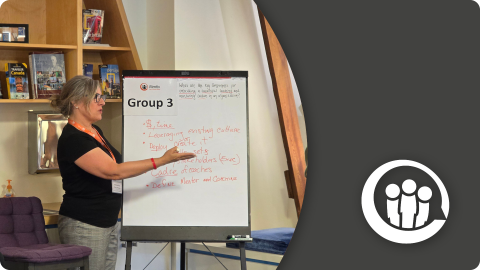In our rapidly evolving business landscape, organisations must continuously adapt to stay competitive.
One of the most effective strategies for maintaining a competitive edge is through reskilling and upskilling the workforce – a topic that 54.9% of L&D heads are focussing on in 2024, according to iVentiv pre-event data.
Training employees to acquire new skills or improve existing ones and ensure they remain relevant in an ever-changing market is a big ask for L&D teams; according to Linkedin’s recent Workplace Learning report, ‘25% of LinkedIn members’ skills for the same job role changed by 25% in just six years.’
This blog delves into the key factors impacting reskilling and upskilling, explores the associated challenges, and discusses the implications for Learning & Development teams heading into 2024 and beyond.
Understanding Reskilling and Upskilling
According to a recent LinkedIn Learning article on the topic, reskilling refers to ‘learning new skills outside of the worker’s existing skill set.’ It involves training employees to perform new jobs or tasks, often in response to technological advancements or shifts in business strategy.
Upskilling, on the other hand, focuses on enhancing employees' existing skills to improve performance and adapt to new roles within their current job functions ‘potentially advancing them along their career path.’
Why should organisations invest time and money in upskilling and reskilling their employees?
LinkedIn Learning says ‘the world of work is changing, and this constant evolution requires a workforce that’s more agile than it has ever been.’ Further, the L&D function can be an employee’s best friend when navigating these changes.
In addition, effective reskilling initiatives are critical for a different reason altogether: they allow companies to, according to Jorge Tamayo et al writing for the Harvard Business Review, ‘build competitive advantage quickly by developing talent that is not readily available in the market and filling skills gaps that are instrumental to achieving their strategic objectives.’
What are some of the key drivers of reskilling and upskilling need in organisations?
-
Technological Advancements
Technological change is one of the primary drivers of reskilling and upskilling initiatives. Jorge Tamayo et al highlight that the average half-life of skills is now ‘less than five years, and in some tech fields it’s as low as two and a half years.’
Further, studies by PwC show that ‘one in three jobs is likely to be severely disrupted or to disappear in the next decade because of technological change.’ As new technologies emerge, they render some skills obsolete while creating demand for new competencies.
But how do leaders effectively upskill during such rapid change?
The rise of artificial intelligence (AI) and automation has shifted the skills landscape, necessitating a focus on digital literacy, data analysis, and complex problem-solving skills. Pwc say that equipping the workforce with resilience and agile skills is the best way forward, stating that ‘the upskilling experience involves learning how to think, act and thrive in a digital world that is sustainable over time.’
However, amidst all of this tech change, Gary Kildare, former CHRO at IBM highlights in the iVentiv Pulse Report that, the human element of work won’t be replaced ‘the most promising outlook for AI lies in recognising that humans excel at empathy, judgment, and decision-making.’
-
Behavioural Change and Adaptability
Effective reskilling and upskilling require more than just technical training; they also demand behavioural change and adaptability. BCG data shows that 68% of workers are aware of coming disruptions in their fields and are willing to reskill to remain competitively employed.
According to a report by McKinsey & Company, fostering a culture of lifelong learning is essential for successful reskilling efforts. Employees must, therefore, be willing to embrace new ways of working and continuous learning.
This involves creating an environment where employees feel supported and motivated to pursue new learning opportunities. In the study by Jorge Tamayo et al, they found that ‘employees are more likely to participate [in training programmes] if they understand why the programmes are being implemented and have had a role in creating them.’
-
Organisational Culture and Leadership
Organisational culture and leadership play pivotal roles in the success of reskilling and upskilling efforts, however, according to a study by BCG, only 24% of polled companies made a clear connection between corporate strategy and reskilling efforts.
Leaders, many say, must champion these initiatives, demonstrating commitment through action and communication, otherwise it would be incredibly difficult for organisations to ‘obtain the relentless and distributed effort that such initiatives require to succeed.’ (Jorge Tamayo et al).
Along the same vein, Jorge Tamayo et al say that it is vital for senior leadership to articulate for the rest of the company the ‘connection between reskilling and strategy and to ensure that leadership and management teams understand their shared responsibility for implementing these programs’ rather than silo design and implementation responsibility to the HR function.
When it comes to the role of leadership in upskilling and reskilling strategies, Jay Moore, former CLO at GE Corporate says that leaders should:
- ‘Lead by example and leverage the teams and resources you have available’
- ‘Be keen on supporting change at the individual and organisational level by acting as a “connector” of the business strategy.
A culture that values growth, flexibility, and innovation will encourage employees to take ownership of their development. IBM's CEO, Arvind Krishna, for example, emphasises that "continuous learning is a strategic priority" for maintaining competitiveness in the tech industry.
What are some of the Key Reskilling and Upskilling Challenges Faced by Global Heads?
Implementing reskilling and upskilling programs involves navigating several challenges, including balancing short-term productivity with long-term gains, managing resource allocation, and addressing diverse learning needs.
-
Resource Allocation
To many leaders, the demand for significant investment in terms of time, money, and resources is the biggest factor when it comes to implementing effective reskilling and upskilling opportunities.
Balancing these investments with other business priorities can be challenging, especially when the ROI isn’t immediately evident. However, according to the World Economic Forum, ‘investment in reskilling and upskilling of the current global workforce has the potential to boost GDP by $6.5 trillion by 2030.
-
Diverse Learning Needs
According to research by ATD, developing learning initiatives that ‘adjust not only to the diversity of business needs but also to the diversity of learners is imperative.’ In this sense, a ‘one-size-fits-all approach to learning just won’t do.
Employees have varied learning approaches and preferences, making it essential to offer diverse training options, and such personalised learning experiences require sophisticated planning and resource allocation. The CIPD says that ‘it can be more expensive to have an increase in educational resources to suit the needs of every student.’
But do the benefits of personalised learning experiences outweigh the cost?
Whatfix research suggests that, as well as reducing attrition rates and increasing talent attraction, this type of investment ‘positions the organsation as an employer of choice for individuals seeking continuous learning and advancement.’
-
Measuring Impact and Effectiveness
Organisations need robust metrics to evaluate training effectiveness and ensure that learning outcomes translate into improved performance. However, according to Kari Clarckson, Content Marketing Manager at D2L ‘46% of learning leaders find calculating the return on investment (ROI) of their corporate learning programs is challenging.’
Additionally, she says ‘40% of L&D leaders are challenged by making sure learning sticks.’
Establishing clear links between training programs and business outcomes can be also challenging, with 33% of leaders ‘having trouble defining what metrics to measure.’
The key things to remember when gathering your data?
- Establish KPIs
- Track programme benefits
- Encourage practicing learned skills in practical ways
- Assess productivity
- Evaluate employee retention rates
Reskilling, Upskilling, and Their Impact on the L&D Function
The growing emphasis on reskilling and upskilling significantly influences the role of L&D teams, who must evolve from traditional training providers to strategic partners, closely aligned with business objectives and capable of driving transformational change.
According to EY, ‘Learning is no longer only a retention measurement but becomes key in realising business strategy.’
So in what ways is the role of the L&D function evolving to strategically reskill and upskill the workforce of the future?
-
Innovative Learning Solutions
To meet the diverse learning needs of employees, L&D teams must adopt innovative learning solutions. Dr Marina Theodotou says that ‘online courses, eLearning platforms, and mobile apps have made education accessible to a global audience’.
It’s no small wonder, then, that the L&D function has dived into leveraging this tech to create engaging, flexible training experiences.
In a report by PwC on the effectiveness of VR for soft skills training in the workplace, the authors found that v-learners ‘completed training four times faster than classroom training’ and were ‘four times more focused during training than their e-learning peers.’
-
Data-Driven Decision Making
Shakira Isom, Learning Training Consultant at Anixter Center, says that there are numerous reasons why data-driven decision making matters in an L&D context: not only does it allow professionals ‘to understand the unique needs and preferences of learners’, it also helps to identify skills gaps and ‘empowers L&D professionals to adjust strategies in real time based on learner feedback and emerging trends.’
To further this point, Stephanie Beale, Consulting Senior Manager at EY Belgium says that ‘If applied and analysed correctly, data can be a game changer within the functioning of corporate L&D and help the function earn their spot as a strategic partner.’
To conclude, reskilling and upskilling are essential strategies for organisations seeking to navigate the challenges of a rapidly changing business environment. By investing in these initiatives, organisations can ensure their workforce remains agile, adaptable, and capable of meeting future demands.
The role of L&D teams is pivotal in this process; they must evolve to become strategic partners driving transformational change. By leveraging innovative learning solutions, aligning training with business goals, and utilising data-driven decision-making, L&D can significantly enhance the effectiveness of reskilling and upskilling initiatives.
Frequently Asked Questions
What is the difference between reskilling and upskilling?
Reskilling involves training employees to learn new skills for different job roles, often in response to technological changes or shifts in business strategy. Upskilling, on the other hand, focuses on enhancing existing skills to improve performance in their current job functions and potentially advance their career paths.
Why should organisations invest in reskilling and upskilling their employees?
Organisations should invest in reskilling and upskilling to remain competitive in a rapidly evolving business landscape. As the world of work changes, these initiatives ensure that the workforce remains agile, adaptable, and capable of meeting future demands. Additionally, reskilling helps fill critical skills gaps and builds a competitive advantage by developing talent that is not readily available in the market.
What are some key drivers for the need for reskilling and upskilling in organisations?
Key drivers include technological advancements, which reduce the half-life of skills and necessitate new competencies, and the rise of AI and automation, which shift the skills landscape towards digital literacy, data analysis, and complex problem-solving. Additionally, fostering a culture of lifelong learning and adaptability is essential to address these changes effectively.
What challenges do organisations face in implementing reskilling and upskilling programs?
Challenges include balancing short-term productivity with long-term gains, managing resource allocation, addressing diverse learning needs, and measuring the impact and effectiveness of training programs. Effective programs require significant investment in time, money, and resources, and need to cater to varied learning preferences while demonstrating clear business outcomes.
How can Learning & Development (L&D) teams evolve to better support reskilling and upskilling efforts?
L&D teams can evolve by adopting innovative learning solutions such as online courses, eLearning platforms, and mobile apps to meet diverse learning needs. They should also leverage data-driven decision-making to understand learner preferences, identify skills gaps, and adjust strategies in real time. Aligning training with business goals and utilising advanced technologies like VR can enhance the effectiveness of reskilling and upskilling initiatives.










